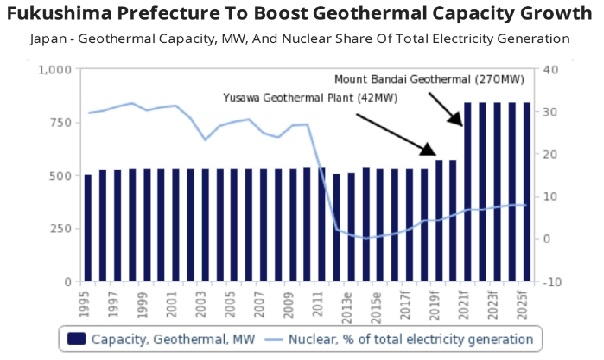
This chart shows Fukushima's increased dependence on geothermal power
A 270MW geothermal power plant is currently in the pipeline in the prefecture.
BMI Research reports that while it thinks Japan's geothermal sector is one of muted growth, outlook for small-scale geothermal power is more buoyant.
Informing this view, the Japanese government has relaxed regulation for the development of small-scale geothermal projects. Prior to 2012, surface surveys and small-scale developments were only allowed in ordinary zones (S1), while it is now permitted also in S2 and S3 zones.
"We believe this change in attitude towards small-scale geothermal energy was prompted by the Fukushima disaster in 2011, which has intensified efforts to boost power generation capacity that can be sourced domestically. This is particularly pertinent in light of Japanese nuclear reactors having been turned offline and fossil fuel imports spiking as the thermal sector have plugged power supply gaps stemming from nuclear closures," BMI said.
Here's more from BMI Research:
Furthermore, in order to circumvent local opposition, Japanese geothermal energy companies are increasingly working closely with the community impacted by their projects, whilst developing smaller-scale facilities that are less intrusive.
Crucially, facilities with a capacity higher than 7MW must undertake more extensive environmental assessments, meaning that developers are able to fast-track smaller developments.
We note that Tokyo-based financial services company Orix's aim to develop up to 15 2MW facilities up to 2020 - which enabled Chuo Electric Power Company to develop Japan's first facility in 15 years - namely the 2MW Kumamoto geothermal plant.
The development of this plant was made possible through close cooperation with the local hot spring company Waita-kai and the Oguni resort. We believe similar developments will support some growth in Japan's geothermal segment.
While we maintain a fairly muted outlook for large-scale geothermal power, we do stress that there could be some exceptions. In line with our view of renewables growth becoming more localised in Japan, there is scope for Japanese prefectures that were very reliant on nuclear power to become more amenable to geothermal power on a larger scale.
As the most pertinent example, a 270MW geothermal power plant is currently in the pipeline in the Fukushima prefecture.























 Advertise
Advertise







